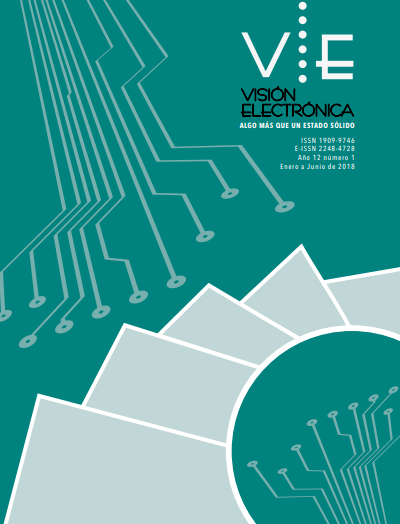DOI:
https://doi.org/10.14483/22484728.14801Publicado:
2018-06-29Número:
Vol. 12 Núm. 1 (2018)Sección:
Visión InvestigadoraAnálisis de ocupación espectral banda GSM 850 en Bogotá
Spectrum occupancy analysis over band GSM 850 on Bogotá
Palabras clave:
BSIC, BCCH, spectrogram, GSM, Qualipoc (en).Palabras clave:
BSIC, BCCH, espectrograma, GSM, Qualipoc (es).Descargas
Resumen (es)
Este artículo presenta un análisis de uso de canales y la medición de ocupación espectral sobre la banda GSM-850 para el enlace downlink mediante dos escenarios de medición; Se definió un sector de Bogotá, Zona norte, sobre el cual se trazó una trayectoria de sensado; identificando parámetros como BSIC, NCC, LAI, MNC, LAC, CI, canal BCCH, frecuencia Uplink, nivel de potencia entre otros; a través del equipo Qualipoc. Se evidenció una cobertura con 17 celdas a lo largo del recorrido de 2.96 Km, con reconexión en dos de las celdas identificadas, resaltando la modulación GMSK como predominante y niveles de potencia aceptables para las estaciones móviles según la norma 3GPP GSM05.05. Posteriormente se realizó la captura del espectrograma en esta misma banda identificando la convivencia de diferentes tecnologías de telefonía móvil y el uso de GSM en varios canales de frecuencias y espacios temporales, con ocupación espectral del 95.2%
Resumen (en)
This paper evidence a channels use analysis and the spectral occupancy measurement for the downlink in Bogota, Colombia, over GSM-850 band. Two test scenarios are defined. First, we select a path of 2.96 Km over North Zone Bogotá to realize the channels search and spectrum detection. The results show parameters like: BSIC, NCC, LAI, MNC, LAC, CI, BCCH channel, uplink frequency, power level received for a mobile telephony operator. Rohde & Schwarz Qualipoc was used to perform the measurements. The Qualipoc equipment found a coverage of 17 cells on the path with a reconnection state in two cells previously identified. After the analysis, we concluded that the GMSK modulation is the most used, reporting stable power level for mobile stations as specified in 3GPP GSM05.05 statement. Finally, the spectrogram measurement indicated the coexistence of different mobile technologies, and the GSM use in several frequency channels and temporal spaces, with 95.2% spectrum occupancy
Referencias
[2] L. F. Pedraza, A. Molina, y I. Paez, “Spectrum occupancy statistics in Bogota-Colombia,” 2013 IEEE Colomb. Conf. Commun. Comput. COLCOM 2013 - Conf. Proc., pp. 2–7, 2013. https://doi.org/10.1109/ColComCon.2013.6564815
[3] L. Gueguen, B. Sayrac, y D. Depierre, “Spectrogram reconstruction from random sampling: Application to the GSM band sensing,” IEEE Int. Conf. Commun., 2009.
[4] L. Mendes, L. Gonzalves, y A. Gameiro, “GSM downlink spectrum occupancy modeling,” IEEE Int. Symp. Pers. Indoor Mob. Radio Commun. PIMRC, pp. 546–550, 2011. https://doi.org/10.1109/PIMRC.2011.6140021
[5] S. D. Barnes y B. T. Maharaj, “A comparison of spectrum occupancy in the South African 900 MHz GSM cellular bands,” IEEE AFRICON Conf., pp. 1–5, 2013. https://doi.org/10.1109/AFRCON.2013.6757597
[6] A. Kliks, P. Kryszkiewicz, J. Pérez-Romero, A. Umbert, y F. Casadevall, “Spectrum occupancy in big cities - Comparative study Measurement campaigns in Barcelona and Pozna,” Proc. Int. Symp. Wirel. Commun. Syst., vol. 9, pp. 125–129, 2013.
[7] T. Zhang, Y. Jia, W. Jiang, J. Gao, S. Yan, y H. Meng, “Wireless indoor localization based on multispectral waterfall maps,” 2014 31th URSI Gen. Assem. Sci. Symp. URSI GASS 2014, pp. 6–9, 2014.
[8] M. Hoyhtya, A. Mammela, M. Eskola, M. Matinmikko, J. Kalliovaara, J. Ojaniemi, J. Suutala, R. Ekman, R. Bacchus, y D. Roberson, “Spectrum Occupancy Measurements: A Survey and Use of Interference Maps,” IEEE Commun. Surv. Tutorials, vol. 18, no. 4, pp. 2386–2414, 2016. https://doi.org/10.1109/COMST.2016.2559525
[9] W. Zhang, H. Han, y M. Li, “Mobile sensing on GSM channel utilization at metropolitan scales,” Proc. - 17th IEEE Int. Conf. Comput. Sci. Eng. CSE 2014, Jointly with 13th IEEE Int. Conf. Ubiquitous Comput. Commun. IUCC 2014, 13th Int. Symp. Pervasive Syst. , pp. 1103–1108, 2015.
[10] P. Singh, M. Kumar, y A. Das, “Effective frequency planning to achieve improved KPI’s, TCH and SDCCH drops for a real GSM cellular network,” 2014 Int. Conf. Signal Propag. Comput. Technol. ICSPCT 2014, pp. 673–679, 2014. https://doi.org/10.1109/ICSPCT.2014.6884924
[11] T. Specification, “ETSI TS 1 Digital cellular teleco communications system" ETSI 2016 France.
[12] . T. Specification, G. Radio, y A. Network, "3gpp ts 25.321", V5.15.0(2009-03) France.
[13] H. Kaaranen and J. W. & Sons, UMTS Networks: Architecture, Mobility and Services. 2005.
[14] T. ETSI Specification, ETSI TS 144 060 "Digital cellular telecomm mmunications system (Phase 2+) (GSM); General Packet Radio Service (GPRS); Mobile Station (MS) - Base Station System (BSS) i) interface; Radio Link Control / Medium Access Control (RLRLC/MAC)protocol," 2016, pp. 0–26.
[15] GSM Association, “Mobile Network Codes and Names Guidelines and Application Form,” no. TS.25, pp. 1–10, 2013.
[16] T. ETSI Specification,"Digital cellular telecommunications system (Phase 2+); Universal Mobile Telecommunications System (UMTS)"; Numbering, addressing and identification (3GPP TS 23.003 version 10.1.0 Release 10), 2010, pp. 0–26.
[17] UIT-T, E.212 "Plan de identificación internacional para redes públicas y suscriptores". 2016.
[18] A. R. & S. GmbH&Co, “News 215/16. In the realm of the world machine,” In the realm of the world machine, pp. 1–10, 2015.
[19] ITU-R, Report ITU-R SM.2256-1. "Spectrum occupancy measurements and evaluation", Informe SM, vol. 2256, no. July. 2012.
[20] A. R. & S. GmbH&Co, “QualiPoc Android.” 12 de enero de 2018, [En línea] Disponible en: https://www.mobile-network-testing.com/en/products/optimization2/qualipoc-android/
[21] T. ETSI Specification, "Digital cellular telecommunications system (Phase 2+); Radio subsystem link control" (GSM 05.08 Version 5.1.0). 1996, pp. 16–17.


.png)




.jpg)





